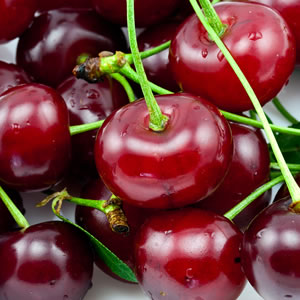- 3 reads

I used to purposely swallow cherry pits when I was younger because I believed doing so would bring good luck. The proverb "life is just a bowl of cherries, so live and laugh and laugh at love" reinforces the ornamental quality of this fruit whose tree produces the most magnificent flowers in the spring.
Cherries, like wine, provoke a deep sensation of joy. More robust than berries but clustery like grapes, the firmest cherries are heart-shaped, like strawberries. It wasn't until recently that I learned that the deep color and extreme mineral density of cherries render them more medicinally potent than the average berry.
75% of all American Montmorency and Belaton tart varieties are produced in Michigan, since the temperate climate of the Great Lakes region is ideal for their growth. This past month, I visited Erwin Orchards Inc., an 88-year-old family cherry farm in South Lyon Michigan. Sweet summer Bing cherries are their early July specialty, but local cherry pickers had been coming so frequently that nearly 70% had been picked by July 10th. "Usually they're gone by the third week of July," proclaimed the manager that day.
Cherries ease inflammatory conditions, reduce water retention, and act as sleep regulators by supplementing melatonin, a sleep hormone. Bioactive ellagic and antocyanine pigments present in both dark red, sweet "Bing" cherries and the lighter, tarter ones (prunus cerasus) help to prevent heart disease, diabetes, cancer and neurodegenerative diseases. These pigments sweep up free radicals in the body, serving as blood-purifiers. Improved memory, relief from headaches, arthritis and gout are the magnificent results. Extremely detoxifying, rich in fiber, potassium, iron, magnesium, folate, and vitamin C, cherries are said to be more effective than aspirin and ibuprofen at healing head pains and muscle inflammations (fibromyalgia). Tests have shown cherries to reduce the size of cancerous tumors in rats and to eliminate cells that cause breast cancer.
My mom, Aunty and I were lucky because we returned home with twenty-one pounds of cherries! That's seven pounds each, not including those we consumed while picking! At three dollars per pound, these organic dark cherries were mostly protected under the IPM (Integrated Pest Management) process of monitoring pests. The U.S. Environmental Protection Agency defines IPM as the most "effective and environmentally sensitive approach to pest management" that relies "on the life cycles of pests and their interaction with the environment." A method of selecting which pests to control, IPM is a mostly organic process that only warrants using chemicals under dire circumstances. The Erwin Orchard practices IPM all year, for both the apples and cherries.
Juices, preserves, sweet candies, dried cherries, pie fillings: feel guilty no longer, because cherries heighten metabolic rates and increase your ability to lose weight. So toss away your oversweet maraschino cherries and pick up some tart ones—both your taste buds and the rest of your body will thank you.

